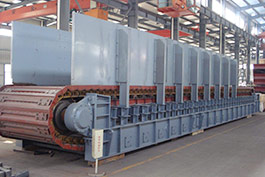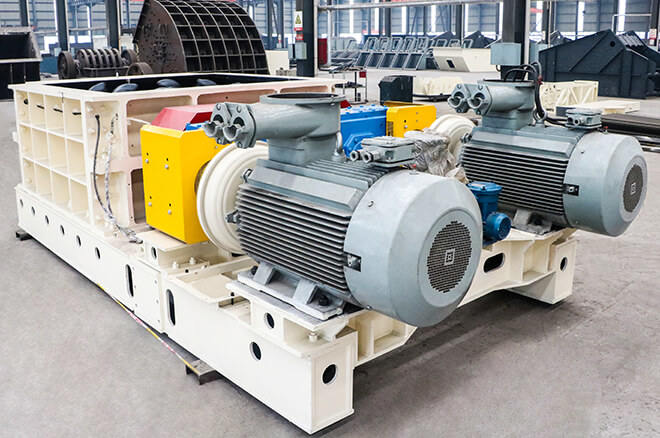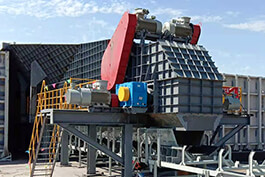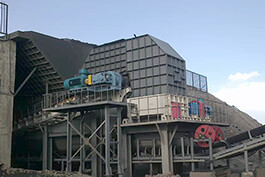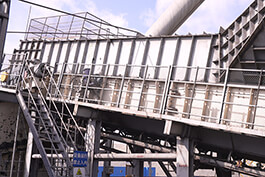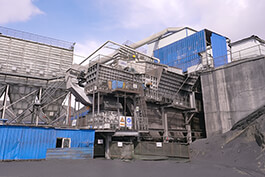The return roller is located on the return portion of the
apron feeder and is usually distributed along the return path of the chain or chain plate. From the appearance point of view, it is a wheel structure with rim, and the material is mostly wear-resistant metal or high-strength engineering plastic to adapt to different working environments and working conditions. Its basic function is mainly to support and guide the apron feeder return chain or chain plate. When the material is transported to the specified position, the unloaded chain or chain plate needs to return to the starting end to continue a new round of material conveying task, at this time, the return roller is like a precise track guide, so that the chain or chain plate can smoothly return along the established route, to avoid deviation, lag and other abnormal situations. Ensure the stable operation of the whole feeder system and improve the conveying efficiency.
.jpg)
The return roller is located on the return track portion of the apron feeder and is usually distributed along the return path of the chain or chain plate. From the appearance point of view, it is a wheel structure with rim, and the material is mostly wear-resistant metal or high-strength engineering plastic to adapt to different working environments and working conditions. Its basic function is mainly to support and guide the apron feeder return chain or chain plate. When the material is transported to the specified position, the unloaded chain or chain plate needs to return to the starting end to continue a new round of material conveying task, at this time, the return roller is like a precise track guide, so that the chain or chain plate can smoothly return along the established route, to avoid deviation, lag and other abnormal situations. Ensure the stable operation of the whole feeder system and improve the conveying efficiency.
Key structure analysis
Although the overall structure seems simple, but in fact each component contains sophisticated design considerations, the various parts cooperate to ensure its efficient and stable operation.
Wheel body
The wheel body is the most important carrying and running part of the return roller, and the choice of its material directly determines the service life and performance of the tug. In most industrial applications, metal materials, especially high quality alloy steel, are widely used in wheel construction. For example, the common 45 steel after tempering treatment, has good comprehensive mechanical properties, high strength, good toughness, can withstand greater pressure and impact, suitable for heavy load, high wear conditions, such as mining apron feeder frequently transport large ores scene.
The surface treatment process of the wheel body can not be ignored. The hardness and wear resistance of the surface of the wheel body can be significantly improved by using hardening technology such as quenching and carburizing. Taking quenching treatment as an example, the hardness of the surface of the wheel body after quenching is greatly increased, which can effectively resist the wear of the material on the surface of the wheel body during the conveying process, thus extending the replacement cycle of the wheel body and reducing the maintenance cost of the equipment. At the same time, a reasonable wheel structure design, such as the height, width of the rim and the thickness of the wheel body and other parameters, need to be accurately calculated and optimized according to the conveyor capacity of
apron feeder, the specifications of the chain or chain plate and the characteristics of the material. The appropriate rim height can effectively prevent the chain or chain plate from derailing during operation to ensure the safety and stability of the transmission; the thickness of the wheel body needs to be determined according to the bearing load to ensure that the wheel body will not be deformed or damaged when bearing heavy loads.
Bearing
As a key component connecting the wheel body and the mounting bracket, the bearing undertakes the important task of supporting the rotation of the wheel body and reducing the friction resistance. In return roller, the commonly used bearing types are rolling bearings and plain bearings. Rolling bearings, such as deep groove ball bearings, tapered roller bearings, etc., have the advantages of small friction coefficient, small starting resistance and high rotation accuracy. The deep groove ball bearing is suitable for bearing a small radial load and a certain axial load, and can ensure the efficient operation of the tug when the apron feeder runs smoothly and the load changes little. The tapered roller bearing can bear the larger radial load and axial load at the same time, for some complex working conditions, the larger force apron feeder, such as in the metallurgical industry, frequent start and stop and conveying material weight is larger, the tapered roller bearing can better adapt to the work requirements to ensure the reliable operation of the tug.
Plain bearings are used in some special occasions because of their simple structure, low cost and large bearing capacity. For example, in some low-speed, heavy-duty and cost-sensitive apron feeder, plain bearings made of copper alloy or babbitt can withstand greater pressure at the same time, through the role of lubricating oil or grease, a uniform oil film is formed between the journal and the bearing, effectively reducing the coefficient of friction and reduce wear. At the same time, the good seismic performance of the sliding bearing also makes it perform well in some occasions where the working environment is harsh and the vibration is large, such as in the apron feeder at the coal mining site, the sliding bearing can better adapt to the vibration condition and ensure the normal operation of the tug.
Whether rolling bearings or plain bearings, the design and maintenance of their lubrication systems are crucial. Reasonable lubrication can effectively reduce the friction and wear of bearings, extend the service life of bearings, and also play a role in heat dissipation and rust prevention. There are two common lubrication methods: Oil lubrication and grease lubrication. Oil lubrication is suitable for high-speed, high temperature working environment, through the oil pump will be forced to the bearing part, to achieve good lubrication and heat dissipation effect; grease lubrication is more suitable for low speed, medium temperature conditions, grease has good adhesion and sealing, can be maintained in the bearing for a long time, providing continuous lubrication protection for the bearing. In practical applications, it is necessary to choose the appropriate lubrication method and lubricant according to the working conditions of the tug and the type of bearing, and regularly check and supplement to ensure that the bearing is always in a good lubrication state.
In the entire material handling system of apron feeder, the return roller works closely with other components to complete the efficient material handling task. Its working principle involves a number of physical processes, including force transfer, motion transformation and the interaction between mechanical structures.
When apron feeder is started, the drive device outputs power through the motor, and after being decelerated by the reducer, the power of high speed and low torque is converted into low speed and high torque power, and is transmitted to the active sprocket. The driving sprocket begins to rotate under the action of the driving force, and then drives the chain or chain plate that engages with it. The chain or chain plate is like a continuous conveyor belt, carrying the material along the established conveyor track to move the material from the feed end to the discharge end.
After the material is delivered to the discharge end to complete the discharge, the unloaded chain or chain plate needs to be returned to the feed end for the next round of material delivery. This is where the return roller comes into play. The return roller provides support and guidance for the return movement of the chain or chain plate through the close contact between the wheel body and the chain or chain plate. Specifically, when the chain or the chain plate is in the process of return, the wheel body of the tug is subjected to the friction of the chain or the chain plate, resulting in a driving torque in the same direction as the chain or the chain plate. Under the action of this driving moment, the wheel body begins to rotate around its central axis. At the same time, because the tug is installed on a fixed bracket, the bracket provides stable support for the tug through the bearing and other components, so that the tug can remain stable during the rotation process, without shaking or deviation.
In terms of force transfer, the friction force of the chain or chain plate that the return roller bears is actually a kind of interaction force. When the chain or chain plate moves forward, it exerts a friction force on the tug, and the tug pushes the chain or chain plate forward through its reaction force. This force transfer process is similar to the friction transfer principle in belt transmission, but in
apron feeder, the contact between the chain or chain plate and the tug is closer, and the force transferred is greater.
In the process of motion transformation, the rotational motion of the return roller directly drives the linear motion of the chain or chain plate. Through reasonable design of the diameter of the tug, the shape of the rim and the pitch of the chain or chain plate and other parameters, the movement speed and stroke of the chain or chain plate can be accurately controlled to ensure the conveying accuracy and stability of the material. For example, in some cases with high material conveying accuracy requirements, such as in the material conveying process on the electronic components production line, by accurately calculating and adjusting the parameters of the tug, the material conveying error can be controlled within a very small range to meet the strict requirements of the production process.
In addition, the return roller also needs to cooperate with other components in the working process, such as tensioning device, guide rail, etc. The role of the tensioning device is to ensure that the chain or chain plate always maintains proper tension during operation by adjusting the tension degree of the chain or chain plate to avoid relaxation or over-tightening. When the chain or chain plate is in the process of return, the tensioning device will automatically adjust its position according to the actual tension of the chain or chain plate, and provide the appropriate tension force for the chain or chain plate. The guide rail provides accurate guidance for the movement of the chain or chain plate to ensure that the chain or chain plate can run smoothly along the predetermined track. The coordination between the return roller and the guide rail is also very critical, and the wheel rim of the tug needs to maintain good contact with the guide rail to ensure that the chain or chain plate will not deviate or derail during operation.


.jpg)
